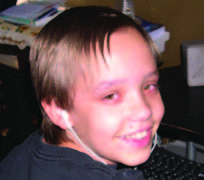By Edna Horton/nw news editor

Keagan Horton, a 12-year-old autistic child and my son, was diagnosed when he was 3 with a form of autism called “pervasive developmental disorder — not otherwise specified.”
Keagan reached every milestone as a baby and with the exception of taking his first steps a little later than normal began talking right along with other children as well.
Around Keagan’s third birthday, his speech stopped completely.
He began throwing tantrums for no reason and would flap his hands vigorously by his ears. He would also rock back and forth on his feet when he became agitated and would take off running full speed at random times with absolutely no regard to the fact that mom and dad were left behind.
When we began to talk to his doctor about what was going on, he was hesitant in diagnosing him with autism. Keagan had some autistic behaviors, but he did not fit the regular profile of an autistic child’s remoteness. He was an affectionate child who would seek people out, not typical behavior for autistic children. They usually are very antisocial.
After a hearing test and a visit to an ear, nose and throat specialist ruled out ear and tonsil problems and a check of his thyroid came back clean, we were sent to a neurologist who gave us the PDD-NOS diagnosis.
Based on the effectiveness for each child, treatments are different. Each autistic child has different behaviors that may be similar to other children, but no two cases are the same. For Keagan, anything physical works best to calm him and helps with his development. He loves physical activity. When we want him to sit down and work, a light brushing of his arms with a soft-bristled brush gets him to sit still in his chair.
Non-verbal, Keagan has learned how to communicate with sign language. Not all autistic children can communicate this way, so they use a system called picture exchange communication system. In PECS, autistic individuals give pictures to their teacher or caregiver of things they want. For example, if they want crackers they will give a picture of crackers to their teacher. If they want to go outside, they will give a picture of the outdoors.
PECS can also grow with the child who can eventually form sentences with the pictures. PECS is an effective form of communication for many non-verbal autistic children, but it was not for Keagan.
My son has come a long way with the help he has obtained from his local school district. Now that he is older and about to head into middle school, I have begun to look into more extensive outside help for him. Thus far, the school system has been wonderful, but I want to accelerate his learning and communication by teaching him how to use a Litewriter.
The Litewriter is a communication device with a keyboard and a small screen. When a phrase is typed, a computer-generated voice will say the phrase out loud. As Keagan gets older, this will help him communicate with everyone, not just people who know sign language, and make him more independent.
In my eyes, the future for Keagan is bright. He is a smart child and will only continue to grow and learn as he gets older. I am confident that despite his different challenges, he will become a wonderful young man.


























